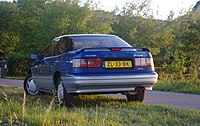|
Hyundai Scoupe
The Hyundai Scoupe, also called the Hyundai S-Coupe, is a 2-door coupé produced by South Korean manufacturer Hyundai from 1990 to 1995, and based on the contemporaneous Hyundai Excel. The name, a portmanteau of "sporty" and "coupe," was pronounced "scoop". HistoryDevelopment of what would become the Scoupe started in 1985. At the 1989 Tokyo Motor Show, Hyundai exhibited a prototype which was named the "Sports-looking Car" (SLC) concept.[2] Regular production began in February 1990; the Scoupe cost ₩521 billion to develop.[2] The drivetrain and underpinnings were largely identical to those of the contemporary Excel/Pony, albeit with marginally shorter gearing to improve acceleration and to give the car a somewhat sportier image.[3] The Scoupe was introduced to the United States market for the 1991 model year at a base price of US$8,495 (equivalent to $19,000 in 2023), thousands less than comparable sporty coupes. The badging used an enlarged, stylized "S" followed by all-caps "COUPE".[4] The naturally-aspirated, in-house developed Alpha engine series replaced the original Mitsubishi design in April 1991, followed by a turbocharged Alpha in October of that same year.[2] The Base and LS models were equipped with the new 1.5-litre, 12-valve, direct-port fuel-injected engine. In the United States, additional changes came with the 1993 model year (July 1992),[2] when Scoupes got a facelift, including the current Hyundai stylized-"H" logo, new flush headlamps plus body-colored side moldings and redesigned front sheetmetal, taillights, and rear bumper. The car was replaced by the Tiburon in 1996. When it was discontinued in 1995, the Scoupe was one of the last cars sold in the United States with motorized seat belts instead of airbags.[4] In total, 242,441 Scoupes were produced: 63,998 sold domestically in Korea and 178,443 produced for export.[2] Scoupe TurboThe Scoupe GT (LS Turbo in the USA) was Hyundai's first attempt at a sports car and featured South Korea's first domestically designed engine with a cast-iron block and crankshaft.[4][5] The engine contains an aluminum head, aluminum pistons and titanium connecting rods. A special compact heatproof ceramic combustion chamber design with central spark plug location was incorporated to optimize engine efficiency. The engine utilizes a Robert Bosch GmbH electronic engine control system and a knock sensor.[citation needed] Thanks to the turbocharging, the engine produces 115 PS (85 kW; 113 hp). The Turbo model can be distinguished externally by a black roof and "TURBO" badging on the rocker sills.[4] Rod Millen drove a modified Scoupe GT (Turbo) to victory in the Showroom Stock 2WD class at the 1992 Pikes Peak International Hill Climb event.[6][7][8]: 39 In mediaThis car made an appearance on BBC's Top Gear Series 13 Episode 2 as Richard Hammond's car for the challenge where the presenters are finding the perfect car for a 17-year-old driver. PreservationHyundai models of the late 1980s and early 1990s are almost impossible to find in preserved condition. As of 2021[update], very few Scoupes are believed to remain in use.[9] Several dedicated groups still exist, the main one being scoupetech found on Facebook. In Korea, the Sports Coupe Family (SCF) was the original Scoupe club, but is now defunct.[10] One facelifted white Scoupe has been preserved and is on display at the Hyundai Namyang Research Institute's R&D History Hall.[2] Millen's Pikes Peak-winning 1992 Turbo has also been preserved.[2] Design and specificationsAs initially launched, the Scoupe was powered by an 81 hp (60 kW), 1.5L Mitsubishi-sourced 4G15 I4 engine (internally referred to as the Hyundai Sirius G4DJ engine), driving the front wheels via a 5-speed manual or 4-speed automatic transmission. The 4G15 was replaced in May 1991 by the 1,495 cc Alpha, with a 75.5 mm (2.97 in) bore and an 83.5 mm (3.29 in) stroke. It was available both as a naturally aspirated engine and a turbocharged engine. The naturally aspirated version produced 92 hp (69 kW) at 5,500 rpm and 97 lb⋅ft (132 N⋅m) of torque at 4,000 rpm, with a 10:1 compression ratio, and the turbocharged version produced 115 hp (86 kW) at 5,500 rpm and 123 lb⋅ft (167 N⋅m) of torque at 4,500 rpm, with a 7.5:1 compression ratio.[11] The naturally aspirated Alpha boasts a 14 percent increase in power over its 1.5-litre, Mitsubishi-designed predecessor, and the turbo produces 42 percent more power. Turbos came only with 5-speed manual shift, while Base and LS models could have an optional 4-speed automatic. Hyundai says the Scoupe was the first production application for Garrett Automotive Products' T15 turbocharger, which was new for the early 1990s. The turbo unit includes water-cooled bearings and housings and an integral wastegate.
Performance MotorWeek tested a base, Orion-engined Scoupe in 1992 and timed the sprint to 60 mph (97 km/h) at 11.9 seconds.[12] The Australian spec S-Coupe GT Turbo has been road tested by several Australian magazines, returning times of 9.2-9.3 seconds for the 0–100 km/h (0–62 mph) sprint and 16.8 seconds for 0–400 m (0–1⁄4 mi).[citation needed] Comparable times for the non-turbo version were approximately 12.5 seconds 0–60 mph (0–97 km/h) with a top speed of 100 mph (160 km/h).[13] The 1988–92 "Base" models with the 4G15/G4DJ achieved 26 / 34 mpg‑US (9.0 / 6.9 L/100 km) city/highway EPA fuel economy ratings when equipped with the manual transmission, and 25 / 32 mpg‑US (9.4 / 7.4 L/100 km) for the automatic. References
External linksWikimedia Commons has media related to Hyundai Scoupe. |
||||||||||||||||||||||||||||||||||||||||||||||||||||||||||||||||||||||||||||||||||||||||||






